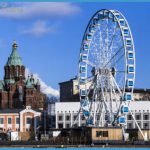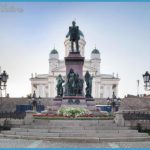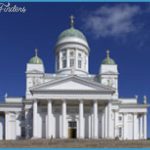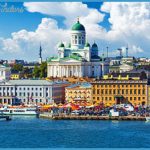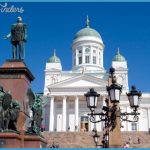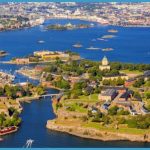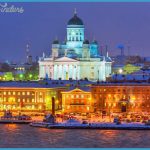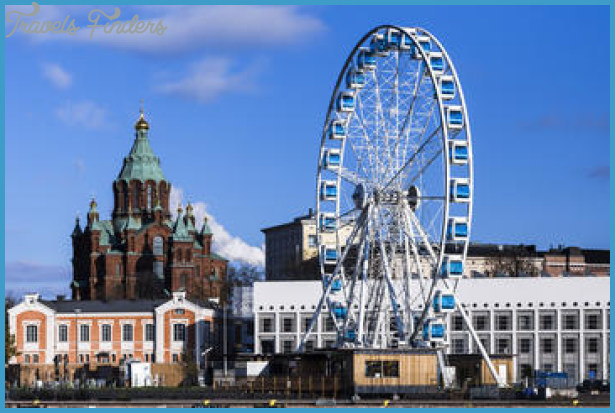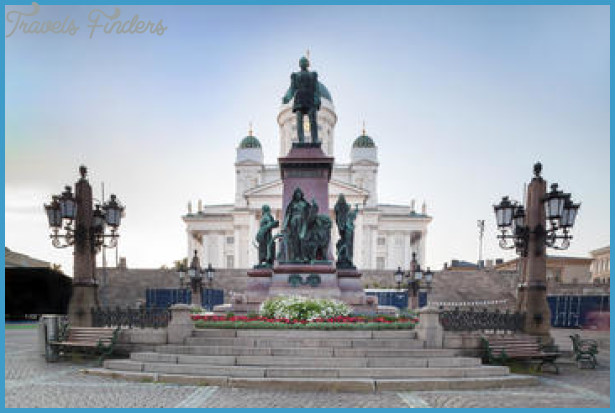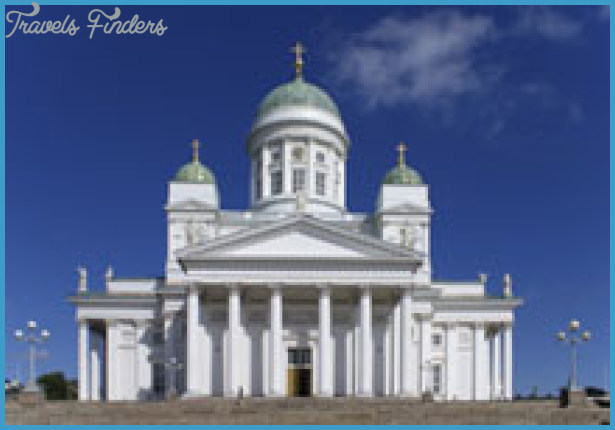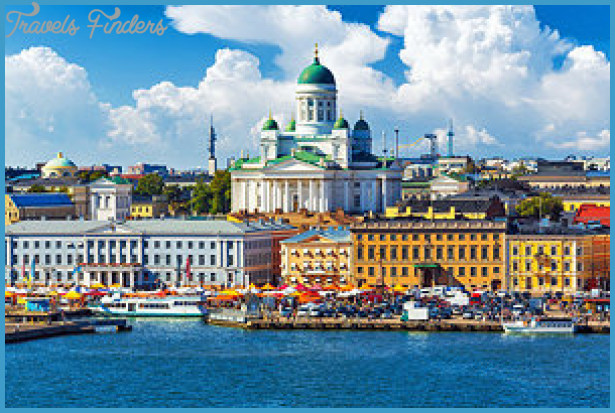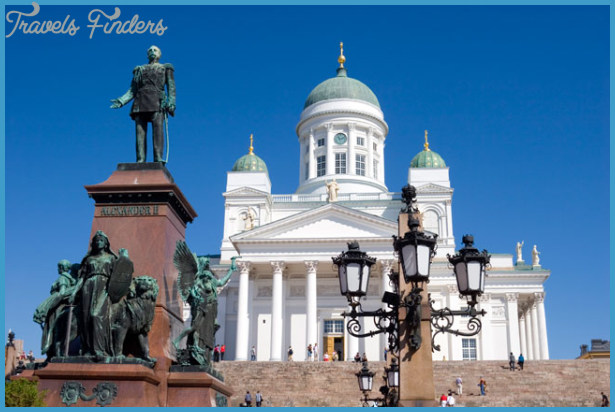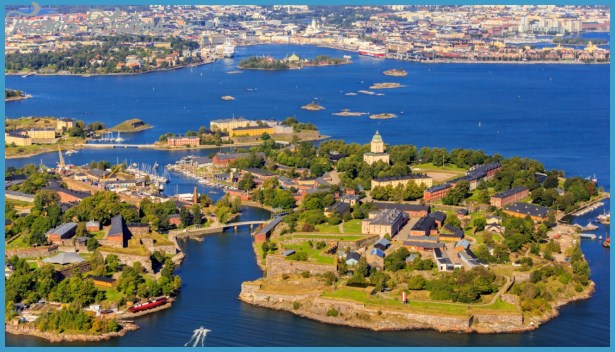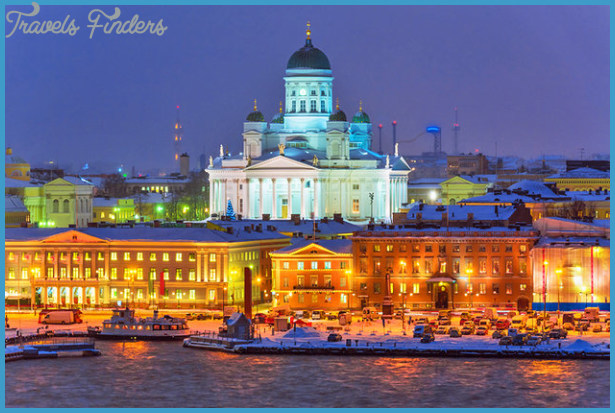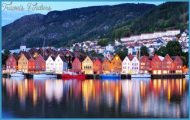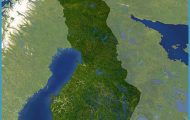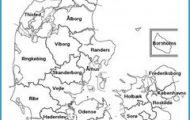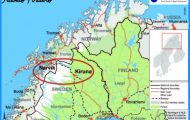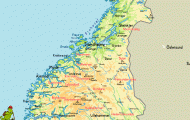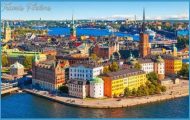The heart of Helsinki is the Market Square (Kauppatori), which is the scene of lively activity on market mornings (Monday to Saturday, 7 a.m. to 2 p.m.) and preserves its own particular charm even in the cold winter months. It lies on the N side of the South Harbour, and has an obelisk commemorating the Empress Alexandra’s visitto Helsinki in 1 833. From here there are boat services to Suomenlinna and the rocky islets called skerries, and the ferries from Sweden come in to the quays on eitherside ofthe harbour. On the N side of the square is the Town House (Kaupungintalo; by Engel, 1833), with a light blue fapade. To the NE is the President’s Palace, and beyond it the Guard-House. On the W side of the square, between the two lanes of the Esplanade, is the Havis Amanda, a beautiful decorative fountain by V. Vallgren (1 908) round which students dance after Graduation, and beyond this the popular Esplanadikappeli Restaurant, with a stage where concerts are given in summer. A little way S, on the seaward side of the Etelaranta, stands the picturesque Market Hall (Kauppahalli, 1891). From the Market Square a bridge leads E to the island of Katajanokka. Here the gilded domes of the Orthodox Uspensky Cathedral (1868) stand out on a hill to the left (icons and paintings in interior).
Parallel to the Esplanade on the N is Aleksanterinkatu, Helsinki’s principal shopping and commercial street. Halfway down the street, in the imposing Senate Square (Senaatintori), stands a bronze statue of Tsar Alexander II (by W. Runeberg, 1894). On the N side of the square a broad flight of steps leads up to the very white Lutheran Cathedral (Tumiokirkko) of St Nicholas (frequently called the Wedding Cake), standing 1 0 m (35 ft) above the square on a granite crag (begun in 1 830 to the specifications of Engel and completed in a different style in 1852). (Statues of Luther, Melanch-thon and the Finnish reformer M. Agricola; a fine organ.) On the W side of the square is the University (Yliopisto), built by Engel in 1828-32 and extended in 1936 to Fabianinkatu. To the N of the University is the University Library (Ylio-piston Kirjasto), also designed by Engel (1836-45), containing 1,500,000 volumes and 2000 manuscripts, including the largest collection of Slav works in the West. The Library is generally regarded as the finest building by Engel in Helsinki. Opposite the University stands the Government Palace (Valtionenvoston Linna), which from 1 809 to 1 91 8 housed the Senate ofthe Grand Duchy of Finland. It is now occupied by the Foreign Ministry and other government offices. The Russian Governor-General, Nikolay Bobrikov, was assassinated on the steps of the Senate by Eugen Schauman in 1 904. On the other side of Aleksanterinkatu can be seen the two-storey Sederholm House, the oldest stone building in the city. Beyond the Government Palace is the Knights’ House (Ritarihuone, 1858-61), once the meeting-place ofthe knights and
South Harbour, Helsinki, with the Market Square and Cathedral nobility, now little used and partly rented out for a variety of purposes. On the first floor are the coats of arms of the Finnish nobility. Opposite the Knights’ House, on the other side of Hallituskatu, are the headquarters of the Finnish Literary Society (Suomen Kirjallisuuden Seura), founded in 1 831.
From Senate Square Snellmaninkatu runs N, passing on the right, on the far side of Kirkkokatu, the former House of Estates (1 891), now occupied by various learned societies. Above the entrance is a bronze group (by Wikstrom, 1903) depicting Tsar Alexander I at the Diet of BorgS in 1 809. Opposite, in front of the Bank of Finland stands a bronze statue of the Finnish statesman and philosopher J. V. Snellman (1806-81), who secured the recognition of Finnish as an official language on an equal basis with Swedish. Opposite the Bank to the N, at the corner of Rauhankatu, are the National Archives. A little way NE, at 1 Maurinkatu, is the Finnish Military Museum.
From Senate Square Aleksanterinkatu runs W; this section of the street is busier and livelier than the lower part. In the middle ofthe street, at its intersection with the broad Mannerheimintie, is a sculpture by F. Nyland, the Three Smiths (1 932), scarred by Soviet bombing. To the left is Stockmann’s department store, established by a Lubeck man, G. F. Stockmann, who started with a small general store at the corner of Aleksanterinkatu and Unioninkatu in 1862. The present store extends to the left along Mannerheimintie almost to the Esplanade.
In the gardens between the two lanes of the Esplanade stands the semicircular building of the Swedish Theatre (Ruot-salainen Teatteri), originally built to Engel’s plans in 1863-6 and replaced by the present structure (by Jarl Eklund and Eero Saarinen) in 1 936. To the E of this are a sculptural group by G. Finne (1 932) commemorating the Swedish-Finnish poet Zachris Topelius and a bronze figure of the Finnish writer Eino Leino (1 878-1 926) by Lauri Leppanen (1 953). Half-way along the Esplanade is a bronze statue of the poet J. L. Runeberg by his son W. Runeberg (1885); on the base is the first verse of the Finnish national anthem, Our Country, which was written by the elder Runeberg. In the northern part of the Esplanade (Pohjoisesplanadi), at the corner of Kluuvi-katu, is a building which was removed stone by stone in the early 1 960s so that the unstable foundations could be renewed and then was rebuilt, leaving the fapade unchanged. In this building, formerly a hotel, Finland announced its surrender at the end of the Winter War in 191-0. Earlier, in 1918, it had been a German headquarters. Almost opposite, at the corner of Etela Esplanaadikatu and Fabianinkatu, is a small palace (by Engel,
1 824) which was the residence of the Russian Governor-General from 1832 to 1 917. Now used as a state guest-house, it is popularly known as Smolna, having been the temporary headquarters of the revolutionary government in 1 91 8, as was the Smolny Institute in Petrograd.
The Esplanade is continued SW by the Boulevard (Bulevardi). On the right of this street, beyond Yrjonkatu, are a cemetery (used until 1829), the wooden Old Church, built by Engel for use pending the completion of the Cathedral, and two monuments commemorating the Finnish and the German dead ofthe 1 91 8 war of liberation. At the corner of Yrjonkatu and Lonnrotinkatu is a mausoleum containing the remains of J. Seder-holm, architect of the Helsinki town plan. Many plague victims are buried in the cemetery here. Opposite the church can be seen a monument (by Emil Wickstrom, 1902) to the doctor and philologist Elias Lonnrot (1 802-84), who collected, edited and published the various parts ofthe Finnish national epic Kalevala. Beside Lonnrot, on the monument, is Vainamoinen, the smith in Kalevala, and at his feet is Suomen Neito (Maid Finland). At 27 Yrjonkatu is the Amos Anderson Museum of Art. Farther along the Boulevard, at the corner of Albertinkatu (on right), stands the National Opera House, and at the far end, on the left, the Sinebrychoff Art Collection contains 17th and 1 8th c. pictures; furniture and other works of art.

